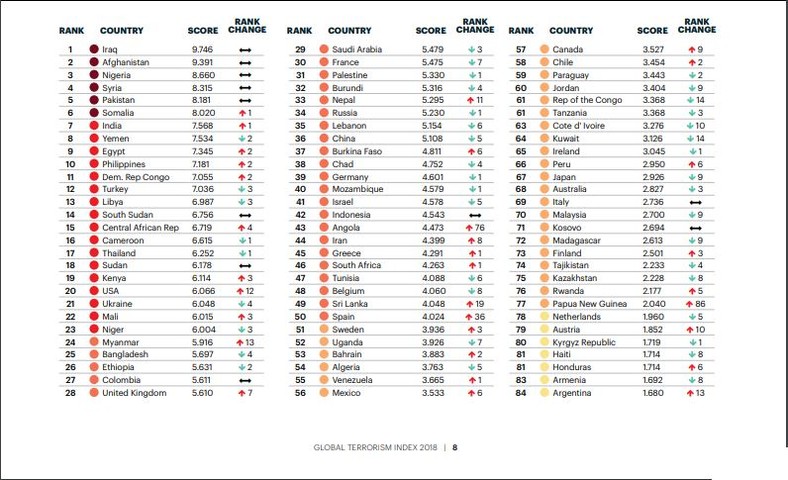While the global terrorism index reported that deaths from terrorism fell by about 27% in 2017, Nigeria was still ranked third on the list of most terrorized countries with a score of 8.660. Other Africans in the top 20 are Somalia and Egypt with a score of 8.020 and 7.345 respectively.
The drop from the Global Terrorism Index released in December 2018 continues the trend of consistent dwindling of terrorism deaths since 2014. The reason for the welcome dwindling in numbers is the result of ISIL’s continuing decline. The index reports that, “The number of deaths from terrorist attacks attributed to ISIL fell by 52 per cent in 2017, with total incidents falling by 22 per cent.
The index reports that, “The number of deaths from terrorist attacks attributed to ISIL fell by 52 per cent in 2017, with total incidents falling by 22 per cent.
“There was a corresponding decrease in the lethality of attacks, highlighting the weakening capacity of the organization. ISIL has now lost most of its territory and sources of revenue and is actively redirecting resources away from the Middle East and into North Africa, sub-Saharan Africa, and Southeast Asia.”
The shift of base to Africa is highlighted in how Somalia and Egypt recorded the largest increases in the number of deaths from terrorism in 2017. The index reports that, “In Somalia, Al-Shabaab was responsible for the single largest terrorist attack in 2017, when a truck bomb detonated outside a hotel, killing 587 people.
“Egypt experienced the second largest terrorist attack of 2017, when the Sinai Province of the Islamic State attacked the al-Rawda mosque, killing 311 people and injuring 122. The attack was the deadliest in Egyptian history.”The move to Africa is further aided by vast uninhabited lands, vast ungoverned areas and blind spots, incredible rates of illiteracy, conflict and poverty which means great hideouts, bases and an incredible pool of potential new, raw recruits from the equally vast numbers of Muslims in most of these areas.
So far, it’s been working well for notorious terrorist cells as Boko Haram, Al-Shabaab and Islamic State West Africa Province (ISWAP).
The Global Terrorism Index says, “Conflict remains the primary driver of terrorism in most countries throughout the world. The ten countries with the highest impact of terrorism are all engaged in at least one conflict. These ten countries accounted for 84 per cent of all deaths from terrorism in 2017.
“When combined with countries with high levels of political terror the number jumps to over 99 per cent. Political terror involves extra-judicial killings, torture and imprisonment without trial.”The matter is further amplified by a video recently released by Vox Atlas, which breaks down how middle-eastern sects have gone about making Africa a bed of attacks over the past 10 years. The video also further highlighted the fears of many that some of the most notorious African terror cells are affiliated to Al-Quaeda and ISIS. The narrator also calls Africa, “one of the most dangerous places in the world.”Sadly, Nigeria was named as the bedrock of all the madness with Boko Haram – after they started launching strikes in 2009. The narrator then pivoted Boko Haram’s penchant for kidnapping kids who are forced to carry out terror attacks before gaining global notoriety with the kidnap of the ‘Chibok Girls’ in 2014.
Shortly after, with a horde of foot soldiers while recruiting many more, they declared Northern Nigeria a Caliphate and then reportedly associated with the Islamic State of Iraq and Syria (ISIS) now, Islamic State of Iraq and Levant (ISIL).
Within a few years, Boko Haram had killed nearly 25, 000 people – the video called it the “deadliest terror group in the world,” replacing ISIS at the time.With a concerted effort from some world powers, Nigeria pushed back, but Boko Haram found the key to what is now the major ingredient to Africa being a hotbed for terrorism – they moved to an area of Chad with little governmental influence - a security blindspot.
Sadly, after they settled in Chad, they moved to other blind spots without governmental influence and across the same path, hitting parts of Cameroon and Niger.
As Boko Haram grew stronger, the Islamic State of West Africa Province (ISWAP) started offering protection to affected people, equipped villages with facilities like water and food, provided stability and security while tempting some of its youthful inhabitants to join them as foot soldiers.ISWAP has since moved into Nigeria, Niger and Chad, launching attacks at random with affiliations to ISIL. Like Boko Haram, ISWAP and other terrorist cells have been using the ungoverned areas along the Sahel and security blindspot stratagem to their advantage.
They also chose right; most of the inhabitants of these areas are Muslim, food is scarce, and ethnic tensions are on a high. The strategy is working as in 2012, a terror cell took over Northern Mali for 10 months and declared it a Caliphate before French forces drove them back.
Some of them have since grown affiliated with ISIL and were responsible for the 2018 attack on the French Embassy in Burkina Faso and the 2017 ambush of the US Special Forces in Niger.
May God save us.









No comments:
We have Zero Tolerance to Spam. Chessy Comments and Comments with Links will be deleted immediately upon our review.
Post a Comment